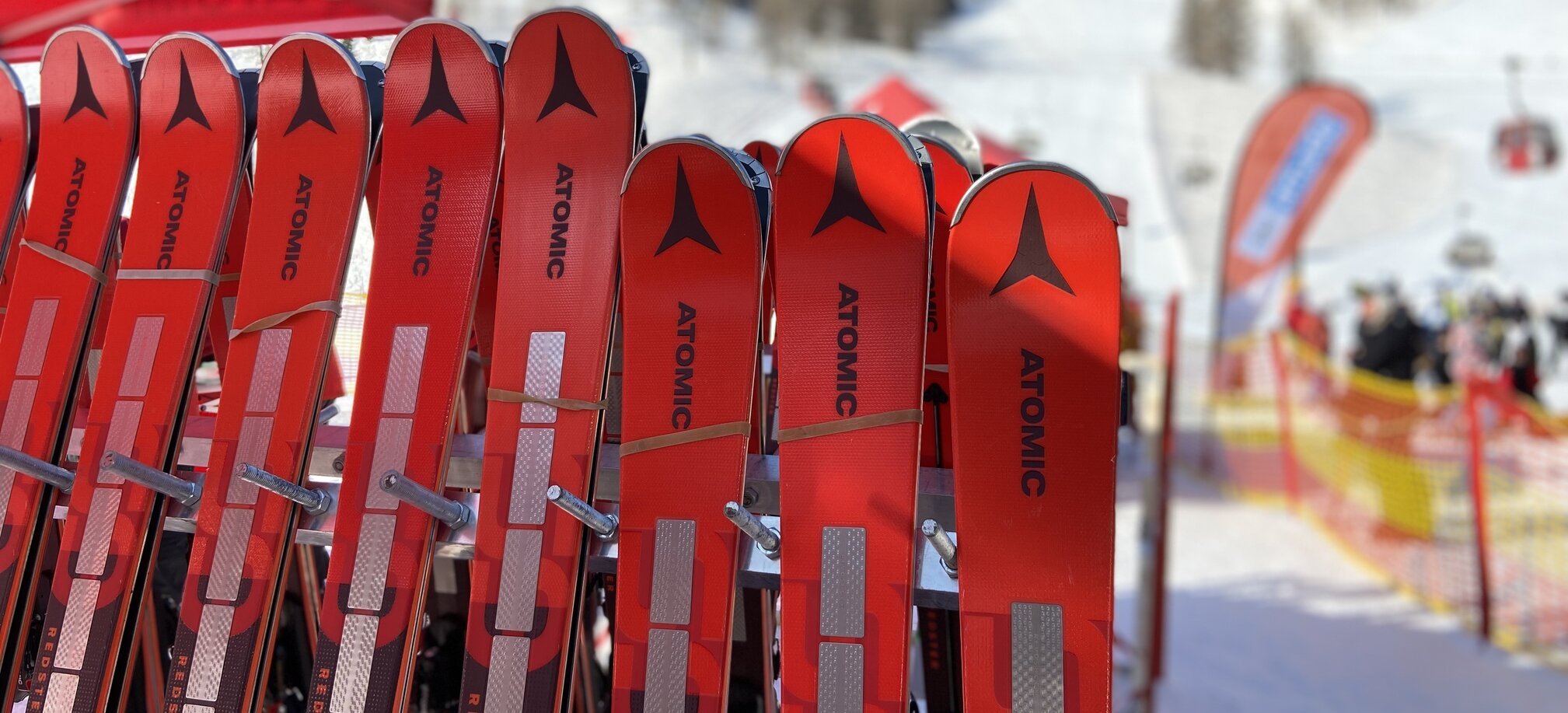Why the right ski length is crucial
Safety and control on the slopes
For many, skis that are too long feel like a stubborn donkey: sluggish on short turns, difficult to control and not at all forgiving. Beginners in particular struggle with the feeling that the skis are skiing them, rather than the other way around. Shorter skis, on the other hand, are easier to turn and allow for quick corrections. This increases control, reduces falls and builds confidence.
Impact on skiing enjoyment and technique
The length of your skis determines how directly they turn, how stable they are at higher speeds and how stable they are on changing terrain. Longer skis are smoother and provide stability at speed. Shorter skis, on the other hand, are more responsive and more forgiving of technical errors. So the length of your skis affects both your progress and your enjoyment of skiing.
Common mistakes when choosing ski length
A common mistake is that beginners choose skis that are too long. This makes it difficult to initiate turns, requires more strength and quickly leads to loss of control – especially on narrow or steep slopes. Shorter skis are easier to turn and give beginners the confidence that they are really in control of their skis. Always remember that you are in control, not the other way around 😉.
Ambitious skiers, on the other hand, sometimes choose models that are too short. Although these offer manoeuvrability, they lose smoothness and stability at higher speeds. Those who ski athletically or prefer longer radii should therefore opt for a slightly longer length.
It is important to note that tables and rules of thumb are only guidelines. The perfect ski length always depends on your personal skiing style, how you feel on the skis and your preferred area of use. Ultimately, it is not the number on the ski that matters, but how you feel on the slopes.
What ski length do I need? – The most important factors
Height and weight as a guide
The rule of thumb remains the same for both men and women: the ski length is usually between the chin and the crown of the head. Those who are lighter in build tend to stay at the lower end, while those who are heavier or very athletic stay at the upper end (or slightly above). Here are the rough starting points:
- Beginners: approx. body height minus 20 cm
- Advanced: –10 cm to body height
- Experts: body height to +10 cm
Skilling level & experience level (beginners, advanced, professionals)
The optimal skiing experience changes depending on your skill level – and so does the right length. Beginners are best off starting with shorter skis – they are easier to control and ensure a smooth introduction to skiing. Advanced and professional skiers love the stability of longer models, which excel at speed and wide turns. Once you are confident on your edges, your skis can grow with your skills.
Area of use and terrain (piste, all-mountain, deep snow)
Where you use your skis most often is a decisive factor in choosing the right length.
Shorter to medium-length skis are advantageous on groomed slopes or when carving. They are more agile, allow for quick changes of direction and provide the typical, clean carving feeling on tight turns.
On the other hand, if you enjoy varied conditions – sometimes on the piste, sometimes venturing into the soft snow at the edge – then all-mountain skis are the best choice. Medium to slightly longer lengths are ideal here, allowing you to ski reliably on both hard surfaces and loose snow.
In deep snow or when freeriding, the motto is: the longer, the better the buoyancy. A slightly longer ski provides stability and keeps you on top of the powder instead of sinking. So if you're looking for freedom away from the slopes, don't be afraid to be a little bolder with the length.
Ski types and their specific length recommendations
Each type of ski has its own characteristics – and therefore also a specific length recommendation.
Race or GS-oriented skis are built for high speeds and large turns. They can therefore be slightly longer to offer maximum smoothness and precision.
Carving skis with slalom characteristics, on the other hand, work better in shorter lengths because they are designed for fast, tight turns. They respond more directly and are particularly fun on the slopes when you are skiing dynamically and in a controlled manner.
All-mountain skis are the versatile all-rounders among the models. They are usually in the medium length range and adapt to your preferred skiing style – whether you spend more time on the piste or in deep snow, you can control this specifically via the length.
Freeride skis, on the other hand, focus on stability in untouched terrain. These skis can be significantly longer to maximise lift and directional stability – perfect for long lines and wide turns in powder snow.
Reference tables and rules of thumb for ski length
Rule of thumb ‘between chin and forehead’ – useful or outdated?
The chin-to-forehead rule still works well as a quick starting point. However, before you go to the sports shop with this guideline, you can narrow it down as follows:
- Light, cautious or agile skiing style? – A few centimetres shorter.
- Sporty, fast, lots of off-piste skiing? – Slightly longer.
Tables according to height and skill level
| Height (in cm) | Beginner | Advanced | Professional |
| 150 - 160 | 135 - 145 | 145 - 155 | 155 - 170 |
| 160 - 170 | 145 - 155 | 155 - 165 | 165 - 180 |
| 170 - 180 | 155 - 165 | 165 - 175 | 175 - 190 |
| 180 - 190 | 165 - 175 | 175 - 185 | 185 - 200 |
| 190 - 200 | 175 - 185 | 185 - 195 | 195 - 210 |
This table provides a good basis and is suitable for both women and men. However, if you are unsure, it is best to ask the professionals directly. At Intersport RENT branches in Ski amadé, the staff will be happy to answer your questions and are sure to find the right skis and poles for you.
Special tables for children and teenagers
A slightly different range applies to children, as control and learning progress are clearly the main focus: skis between the chest and the tip of the nose are a good start. It is better to be slightly shorter than too long – skis that are too long inhibit technical development and make learning unnecessarily difficult.
Frequently asked questions (FAQ) about ski length
I am lightly built – do I need to use shorter skis?
Not necessarily, but it is usually recommended. With the same skiing ability, lighter skiers benefit from shorter lengths within the table because the skis are easier to control and edge cleanly.
I mainly ski in deep snow – how much longer should my skis be?
In powder snow, buoyancy and directional stability are important – here, you can go one size longer (often body height plus 10 cm).
Children & teenagers – what length and when should they switch to adult skis?
As long as technique and control are the priority, the rule is: chest to nose. As your skills and height increase, you can gradually extend the range.
What should I do if the recommended values are between two sizes?
Shorter: more manoeuvrability, easier to control, ideal for tight turns and technique training.
Longer: smoother running and greater stability at speed and in rough snow.
Practical check: 4 steps to finding the right ski length
- Determine the starting value: chin–forehead or level guideline.
- Clarify the area of use:
- Mainly piste → slightly shorter
- All-mountain → medium
- Deep snow → slightly longer.
- Adjust for weight and skiing style: Lightweight and cautious → lower end of the range; heavy/sporty/advanced/fast → upper end.
- Reality check: If possible, test two neighbouring lengths.
Common pitfalls – and tips on how to avoid them
When choosing ski length, there are classic mistakes that even advanced skiers make time and time again. One of the most common is to base your choice solely on your height. Of course, height is an important factor, but it is by no means the only one. Weight, skiing ability, intended use and ski type are just as crucial. Two people of identical height may need completely different lengths – depending on whether they are gliding leisurely down the slopes or ploughing through deep snow.
The myth that ‘longer is always faster’ also persists. This is only true to a limited extent. Although longer skis run more smoothly and offer stability at high speeds, they also require clean technique and more strength. Those who are still honing their turning technique or prefer a leisurely pace often benefit from a slightly shorter version – it forgives mistakes and makes skiing more relaxed.
This issue is particularly important when it comes to children. Many parents buy skis that are designed to be ‘grown into’ – in the hope of getting more use out of them. But the opposite is true: skis that are too long make learning more difficult, take away the little ones' control and slow down the fun of progress. It is better to adjust the ski length regularly so that children can develop their technique in a playful and safe manner. Since children usually grow faster than we would like, it makes sense to hire skis and ski poles, so that you can respond to your child's individual needs each season without putting unnecessary strain on your wallet.
Conclusion: The right ski length is individual – and measurable
With height, weight, ability, area of use and ski type, you have all the variables at your fingertips. Use calculators and tables as a starting point, adjust according to skiing style and confirm your gut feeling on the slopes. With these tips, you'll be well prepared for your next ski purchase.


